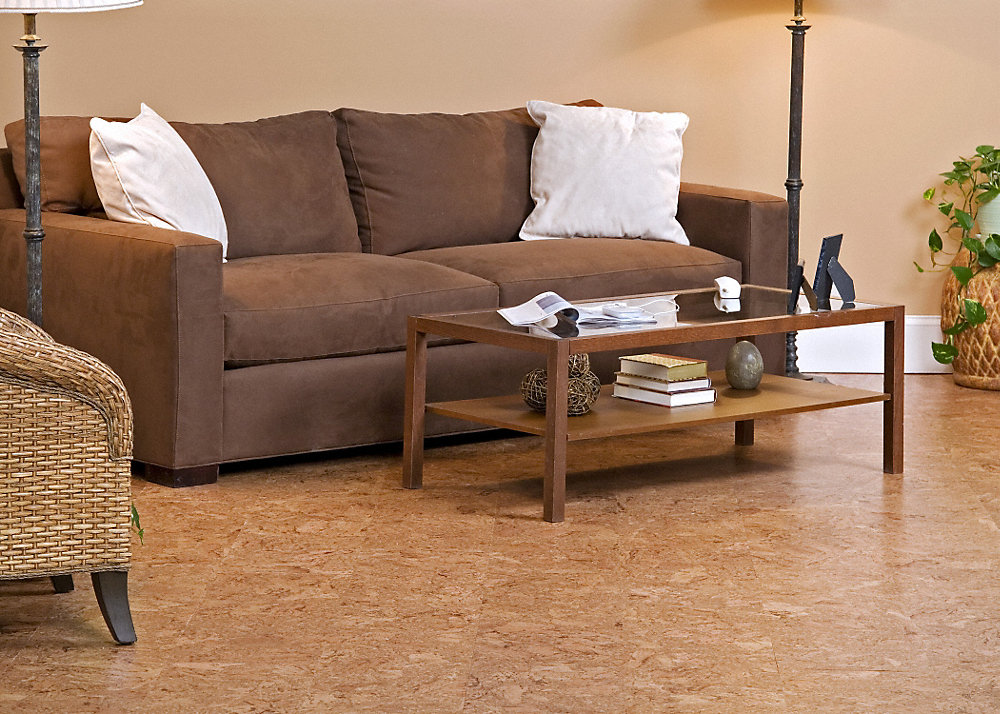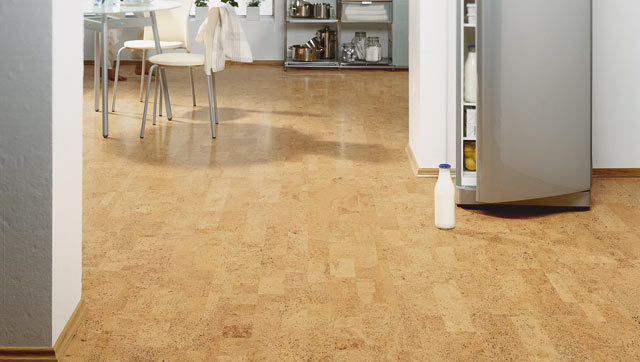Cork Flooring
Advantages and Disadvantages of Cork Flooring
Naturally cushioned, cork floors are produced by peeling away the bark without destroying the tree.
Although cork flooring has been around for many decades, it has recently become the new rage – due to the fact that it’s a “green” renewable resource that can be used without the guilt associated with using fine hardwoods. But, also due to it being a great sound and thermal insulator.
Cork flooring is about as <em>green</em> as it gets. Harvesting doesn’t damage trees, and very little goes to waste. Cork comes from the bark of the cork oak tree (Quercus suber) and is periodically harvested from the living trees. For flooring products, cork is ground up, compressed, and formed into sheets bonded with resins.

It’s good for anyone with allergies because it resists mold and mildew. Cork is also easy on the ears, soft on the feet, and light on the pocketbook. And, more music to our ears: installation is relatively simple if you can follow directions.
While cork isn’t as popular as hardwood or vinyl plank, it’s got serious staying power. In fact, cork can be traced back to Ancient Greece where it was used for construction and insulation. Portuguese and Spanish explorers even used cork on their ships.
Fast forward to today, cork has become a staple in green building. And although 70% of the world’s cork supply comes from Portugal, this flooring can be found in homes and structures across the globe.
Is Cork Flooring right for your home?
Cork flooring has many merits, to be sure, and its trendy popularity has led to cork being used almost everywhere in the home. It is important to understand the characteristics of cork flooring so that you can make an informed decision when choosing whether or not to use it in a specific space.
Advantages of Cork Flooring
Cork flooring has a soft, cushiony surface.
One of the best things about this material is how soft and yielding it feels beneath your feet. When people first step on a cork flooring installation their eyes often light up with delight with the recognition that this is neither wood nor vinyl but something completely different. Because of this, cork is popular in rooms where you will be standing for long periods of time, such as kitchens. This is a typical complaint of vinyl flooring – it’s hard and sounds like concrete when you walk on it.
The soft surface of a cork floor can act as a kind of cushion that provides a certain amount of protection when someone accidentally trips and falls. This makes it a great choice for children’s rooms and for older residents prone to falling.
It’s a good insulator.
The inside of a piece of cork is made up of millions of tiny air-filled chambers. These act as barriers against the transmission of noise, effectively insulating any room. Any room floored with cork will reduce noise from being transmitted through the floor to the ceiling below.
Cork flooring holds the heat. Tired of stepping on to a cold floor in the winter, but hate the look of carpet? Invest in cork flooring. Why? Because cork is a natural insulator.
Unlike tile flooring and other hard surface floors, cork doesn’t allow heat to escape. Its cellular structure holds the temperature of the room and disperses heat evenly. If you live in a colder climate, cork flooring can save you a <em>ton</em> on energy costs year after year. In one study, a standard cork floor had an R-value of 1.125, compared to a value of only 0.250 for ceramic tile and 0.638 for oak. Only wool carpet offers an R-value greater than cork.
Cork can be refinished. One of the best things about a cork floor is that you can refinish its surface periodically, just as you can with hardwood, to give it a fresh new look. This involves sanding the cork down past the point of any imperfections, and then staining and or re-applying the finish sealer to the surface. This can be done several times, depending on the thickness of the material.
Cork is hypoallergenic. Unlike carpet, cork tends to repel dust, hair, and other small particles from its surface. The material is also easier to get completely clean. Because of this, cork floors tend to promote higher indoor air quality.
Cork has antimicrobial properties. Cork contains a waxy substance called suberin. This material has the property of naturally repelling small vermin and insects. This makes cork floors resistant to the growth and colonization of these organisms, and can, therefore, help to promote the healthiness of an environment.
Cork is environmentally friendly.
Cork is a completely natural, recurring, and easily replenishable material. It is made from the bark of the cork oak and is harvested without harming the tree. The cork bark grows back every few years. Cork is also biodegradable and will break down into the environment at the end of its life cycle.
Installing tiles is easy. Installing cork tiles is quite simple since most tile products have a self-adhesive back—installation is a simple peel-and-stick operation. Other products are installed with a standard thin-set mortar adhesive. Finishing is a matter of applying several layers of sealer. When individual tiles become damaged, you can simply lift them up and replace them.
Cork flooring is easy to maintain. Cork is not a maintenance-free floor, but with proper precautions, it will look beautiful for decades. Once your cork floors are sealed, they should hold up well against spills and pet accidents. But, it’s still important to wipe up liquid as soon as possible.
For daily cork floor cleaning, use a static dust broom or a vacuum with a bare floor setting. For tougher jobs, try a mild wood floor cleaner and a damp mop. Standing water and oil-based soaps will damage your floor’s finish, so only use water-based cleaners.
Disadvantages of Cork Flooring
Cork is susceptible to damage. This is not the right material if you are looking for a perfectly pristine floor. Cork is a very soft material. While this might be delightful on bare feet, it also makes these floors relatively easy to damage. If any sharp object is dropped it can puncture the floor. Chair and furniture legs can pierce and scrape the material. High heels, if not properly padded, can cause punctures in the surface of a cork floor. Even small dirt particles can act like sandpaper, tearing across the surface of the material.
If you have very heavy appliances or furniture pieces, then you may have a problem with them sinking permanently down into the cork. This can not only cause permanent divots in the material but can also make it very difficult to move those pieces later on for cleaning or furniture rearrangement. However, this can be offset to some extent by using furniture coasters and placing larger pieces on flat wooden boards or other support pieces. In a kitchen, for example, you may want to rest the refrigerator on a plywood platform over the cork.
Cat and dog nail scratches are a particular problem with cork flooring. These can start showing up almost instantly, especially with larger, heavier dogs. Keeping their nails trimmed can help this, but pets will invariably damage a cork floor.
Water can be a problem. The finishing process involves sealing cork in order to create an invisible barrier over its surface, and this offers some protection against water stains and damage. However, this seal is not perfect, and if the room is flooded, the flooring material will probably warp and discolor. High humidity can also cause cork to curl or plump, which may lead to tiles popping out.
Sunlight can cause cork to fade. If direct sunlight is allowed to beam down on cork materials every day, then discoloration may occur and a patch of the floor can end up taking on a different hue than surrounding areas. This can be prevented by blocking sunlight with curtains or blinds, but it will require constant vigilance and care.
Cork Comparison Guide
Cork vs Carpeting
Like cork, carpeting provides superior soundproofing and insulation. It’s cost-effective and soft underfoot, but carpeting has a short lifespan. If you have pets or small children, carpeting may be an expensive choice. An accidental spill or puddle can ruin your new flooring in under 10 seconds.
In contrast, cork provides better protection against damaging liquids. Once it’s sealed, you can relax a bit. And if by chance your cork falls prey to grape juice, you can always refinish it.
Cork vs Tile
Tile is undoubtedly the most forgiving floor covering on the market. It won’t scratch easily and holds up well to dirt and moisture. But, it’s also cold & potentially uncomfortable. Plus, if you drop something heavy, tile may shatter.
On the other hand, cork may puncture – but it won’t break. Its spongy cells feel like a cloud underneath your feet. However, you will have to watch out for scratches & keep it shaded from direct sunlight.
Cork vs Hardwood
Hardwood is the gold standard for floor coverings. It’s timeless, renewable and adds a special layer of warmth to your space. However, it scratches easily, hates water and can cost a boatload.
By comparison, cork is made from tree bark. It’s slightly less expensive and holds up better than many softer species of wood. Unfortunately, cork can feel a bit “trendy” (same goes with laminate), so if your home’s on the traditional side, hardwood might be a better option aesthetically.
Cork vs Vinyl
Luxury vinyl tiles and planks have become popular over the last several years. Vinyl is an affordable, extremely durable, and offers superior water and scratch resistance. Not only that they resemble a hardwood floor better than ever, with a huge selection of colors and textures.
The only problem is vinyl is not a natural material. There’s a great deal of controversy surrounding manufacturing processes and ongoing concerns about this material’s effect on air quality. And, although it’s improving, it still feels and sounds like plastic when you walk on it.
On the other side of the spectrum: <em>cork</em>. Cork doesn’t contain VOCs or release toxic chemicals into the air. It’s allergy-friendly, hypo-allergenic and resistant to mold and mildew. If you choose cork based on the health benefits, be sure to double check the label for any adhesives or sealants. These products may contain chemical irritants.
Cork can have an interesting look, an appealing price point, and easy installation. So, it’s worth a try to check out some samples. This is not for every space, but it’s a great alternative for those looking for the advantages it gives you. Check out the selection here on Floor Sellers.




